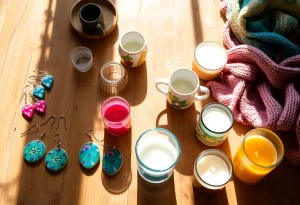Table of Contents
Understanding Etsy’s Marketplace Dynamics
Etsy has become a powerhouse for handmade and vintage goods, with over 7.5 million active sellers as of 2023. This vibrant marketplace saw $13.3 billion in gross merchandise sales last year, showcasing its immense potential for creative entrepreneurs.
The platform’s success stems from its diverse product categories, each with its own passionate customer base. Here are some of Etsy’s top-performing categories:
- Handmade jewelry
- Personalized gifts
- Home decor
- Vintage clothing
- Art prints
Etsy sellers come from all walks of life, but they share a common thread – creativity and a desire for independence. The typical Etsy seller is:
- Female (86% of sellers)
- Between 25-44 years old
- Running their shop as a side hustle
- Earning an average of $2,900 per year from their shop
Success on Etsy often depends on finding the right niche and standing out in a crowded marketplace. Let’s take a look at some strategies top sellers use to boost their Etsy sales:
While Etsy offers great opportunities, managing multiple sales channels can be challenging. Tools like Marketplace Connect help sellers streamline their operations across platforms, saving time and reducing errors.
Understanding Etsy’s marketplace dynamics is crucial for sellers looking to make their mark. By focusing on popular categories, tailoring products to customer needs, and leveraging the right tools, sellers can tap into Etsy’s vast potential and grow their businesses effectively.
Top-Selling Product Categories on Etsy
Etsy is a goldmine for unique, handmade items. But some categories really shine when it comes to sales. Let’s dive into what’s hot on this creative marketplace.
Handmade jewelry and accessories are always in demand. From delicate necklaces to statement earrings, shoppers love one-of-a-kind pieces that express their style.
- Personalized items
- Custom name necklaces
- Birthstone bracelets
Next up, home decor and furnishings are big sellers. People want their spaces to feel special, and Etsy’s handcrafted touches do just that.
Art prints and digital downloads are gaining traction too. They’re easy to ship and offer instant gratification for buyers.
This video breaks down some key strategies to boost your Etsy sales, no matter what category you’re in.
Lastly, vintage clothing and collectibles have a dedicated following. Etsy’s a go-to for folks hunting for that perfect retro piece.
Niche Markets and Trending Items
While the big categories are great, don’t overlook niche markets. They can be less competitive and super profitable if you hit the right spot.
- Eco-friendly and sustainable products
- Pet accessories and personalized pet items
- Craft supplies and DIY kits
- Wellness and self-care products
- Tech accessories and gadget organizers
Eco-friendly stuff is huge right now. People want to shop with a clear conscience, and Etsy’s handmade vibe fits perfectly with this trend.
Pet owners are another goldmine. They love spoiling their furry friends with unique, personalized gear. Think custom pet portraits or hand-knitted sweaters for dogs.
- Biodegradable dog toys
- Personalized cat bowls
- Custom pet bandanas
Craft supplies are always in demand. With more people picking up DIY hobbies, selling supplies can be a steady income stream. Plus, it’s easier to manage inventory for supplies than finished products.
Wellness and self-care items are trending hard. From aromatherapy candles to handmade soaps, people are investing in feeling good at home.
Optimizing Your Etsy Shop for Success
Having great products is just the start. To really succeed on Etsy, you need to optimize your shop. Here’s how:
| Strategy | Why It Matters |
|---|---|
| Compelling titles and descriptions | Helps buyers find your items |
| High-quality photos | Showcases your products effectively |
| Smart pricing | Balances profit and competitiveness |
| Etsy SEO | Improves visibility in search results |
| Excellent customer service | Leads to positive reviews and repeat customers |
Crafting compelling product titles and descriptions is crucial. Use keywords buyers might search for, but keep it natural. No keyword stuffing!
Photos can make or break a sale. Invest in good lighting and take clear, detailed shots of your products. Show them from multiple angles if possible.
Pricing can be tricky. Research similar items, factor in your costs, and don’t undersell yourself. Remember, on Etsy, people expect handmade quality, not bargain-bin prices.
Etsy SEO is its own beast. Use relevant tags, update your shop regularly, and stay on top of Etsy’s algorithm changes. It takes work, but it pays off in visibility.
Customer service can set you apart. Respond quickly to messages, be clear about shipping times, and go the extra mile when you can. Happy customers leave good reviews, and good reviews lead to more sales.
Managing all these aspects of your Etsy shop can be a lot, especially if you’re selling on multiple platforms. That’s where tools like Marketplace Connect come in handy. It helps sync your inventory and orders across different sales channels, saving you time and headaches.
Remember, success on Etsy doesn’t happen overnight. Keep refining your products, optimizing your shop, and providing great service. With persistence and the right strategies, you can turn your Etsy shop into a thriving business.
Maximizing Your Etsy Business Potential
Etsy sellers face unique challenges when scaling their businesses. The key to success lies in striking a balance between product diversity and maintaining a cohesive shop identity. Let’s dive into some strategies to help you maximize your Etsy potential.
Product Diversity vs. Shop Cohesion
- Expand your product line gradually
- Ensure new items align with your brand aesthetic
- Test new products in small batches
- Listen to customer feedback for product development
By carefully curating your product offerings, you can attract a wider customer base while staying true to your shop’s core identity. This approach helps build brand loyalty and encourages repeat purchases.
Multi-Channel Selling Strategies
- Start with Etsy as your primary platform
- Expand to complementary marketplaces (e.g., Amazon Handmade)
- Create a standalone website for direct sales
- Use social media platforms for additional exposure
Expanding to multiple channels can significantly boost your sales potential. However, managing inventory across platforms can be challenging. This is where tools like Marketplace Connect come in handy, streamlining order management and inventory updates across various sales channels.
Analyzing sales data is crucial for making informed product decisions. Here’s a simple framework to guide your analysis:
| Metric | Action |
|---|---|
| High-selling items | Increase production, create variations |
| Low-selling items | Reassess pricing, improve listings, or discontinue |
| Seasonal trends | Plan inventory accordingly |
| Customer demographics | Tailor marketing and product development |
By leveraging these insights and utilizing multi-channel selling tools, you can scale your Etsy business efficiently while maintaining the unique charm that attracts customers to handmade and vintage items.
Wrap-up Your Etsy Success Strategy
Selling on Etsy can be a great way to boost your business, but it takes some know-how to really make it work. We’ve covered a lot of ground on the best-selling items and how to make your shop stand out. Let’s recap the key points:
• Personalized and custom items are huge sellers
• Handmade jewelry and accessories remain popular
• Vintage and upcycled goods have a dedicated market
• Digital products offer passive income potential
Remember, success on Etsy isn’t just about what you sell – it’s how you sell it. Optimizing your listings, taking great photos, and providing top-notch customer service are all crucial. And don’t forget to keep an eye on trends and adjust your offerings accordingly.
For those looking to expand beyond Etsy, multi-channel selling can be a game-changer. Tools like Marketplace Connect make it easier to manage inventory and orders across different platforms. This approach lets you reach more customers without multiplying your workload.
Ready to take your Etsy shop to the next level? In the next section, we’ll answer some common questions to help you get started. Whether you’re just launching your shop or looking to boost sales, there’s always room to grow and improve your Etsy business.
Common Questions About Selling on Etsy
How do I start an Etsy shop?
Starting an Etsy shop is simple. Go to Etsy.com, click “Sell on Etsy,” and follow the setup wizard. You’ll need to choose a shop name, add listings, set up payment and shipping info, and create shop policies. The process takes about 30 minutes if you have your product photos and descriptions ready.
What are Etsy’s fees?
Etsy charges several fees. There’s a $0.20 listing fee per item, a 6.5% transaction fee on sales, and payment processing fees (varies by country, typically around 3% + $0.25). They also offer optional advertising services for additional fees. It’s important to factor these costs into your pricing strategy.
How do I handle shipping for Etsy orders?
Etsy provides tools to help with shipping. You can set up shipping profiles for different types of items, print labels directly through Etsy, and even offer calculated shipping rates. Many sellers use flat rate shipping for simplicity. Remember to package items securely and consider insurance for valuable items.
Can I sell on Etsy and other platforms simultaneously?
Yes, you can sell on multiple platforms including Etsy, your own website, and other marketplaces. However, managing inventory across different channels can be challenging. Tools like Marketplace Connect can help by syncing your inventory and orders across platforms, making multi-channel selling much easier. Check out our Shopify app for seamless integration.
What are the best selling items on Etsy?
Popular categories on Etsy include handmade jewelry, personalized gifts, home decor, and craft supplies. Unique, customizable items often perform well. However, the best strategy is to focus on products you’re passionate about and can create consistently with high quality. Trends change, but authentic, well-crafted items always have a market.
How can I improve my Etsy shop visibility?
To boost your Etsy shop visibility, focus on SEO by using relevant keywords in titles and tags, offer competitive pricing, use high-quality photos, encourage customer reviews, and keep your shop policies clear and customer-friendly. Regularly adding new items and participating in Etsy’s promotional events can also help increase your shop’s exposure.





